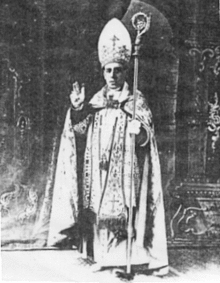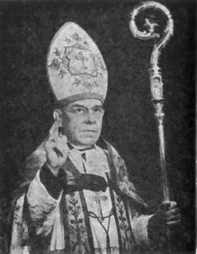Carmel Henry Carfora
Henry Alfonso Mary Carfora (a.k.a. Carmel Henry Carfora) (August 27, 1878 – January 11, 1958), the son of Ferdinand Carfora and Angeline D'Ambrosio, was baptized Roman Catholic in his native Naples, Italy on August 29, 1878. He entered the Franciscans in 1894 and was ordained deacon by Bishop Giuseppe Ciglano on August 15, 1901 and priest by Bishop Francesco Vento of Aversa on December 21, 1901. He immigrated to America and served in New York. In 1906 he was called to the Diocese of Wheeling to minister to Italian immigrants. Eventually, in 1908, he left the Roman Catholic Church.
The Most Reverend Carmel Henry Alfonso Mary Carfora | |
|---|---|
| Archbishop and Primate | |
 Carfora in cope and miter with crozier (c. 1918) | |
| In office | 1919-1958 |
| Predecessor | Rudolph de Landas Berghes et de Rache |
| Successor | Disputed |
| Orders | |
| Ordination | December 21, 1901 by Bishop Franceso Vento, Bishop of Aversa |
| Consecration | October 4, 1916 by Rudolph de Landas Berghes et de Rache or Joseph Rene Vilatte |
| Personal details | |
| Born | August 27, 1878 Naples, Italy |
| Died | January 18, 1958 (aged 79) Chicago, Illinois, USA |
| Denomination | Old Roman Catholic Church |
| Motto | "For God and Humanity" |
| Coat of arms |  |
Ordination history of Carmel Henry Carfora | |||||||||||||||||||||||||||||||||||
|---|---|---|---|---|---|---|---|---|---|---|---|---|---|---|---|---|---|---|---|---|---|---|---|---|---|---|---|---|---|---|---|---|---|---|---|
| |||||||||||||||||||||||||||||||||||
| |||||||||||||||||||||||||||||||||||
Carfora assumed leadership of a group of parishioners who broke away from St. Anthony of Padua Catholic Church, in Youngstown, Ohio, to found St. Rocco's Independent National Catholic Church on May 17, 1907.[1] He later formed mission congregations which ministered to various ethnic immigrant groups whom he perceived as unable to gain adequate pastoral support from the Roman Catholic authorities. In June, 1912 he incorporated his work as the National Catholic Diocese in North America, for a time under the episcopal oversight of Bishop Paolo Miraglia-Gulotti, leader of the Italian National Episcopal Church. Rudolph de Landas Berghes took up residence at St. Dunstan's Abbey, Waukegan, Illinois and raised Abbot William H. F. Brothers to the episcopacy on October 3, 1916. The following day he consecrated Carfora as a bishop of the North American Old Roman Catholic Church. St. Rocco's was disbanded until it was received into the Episcopal Church on June 15, 1918. In 1917 de Landas Berghes and Carfora united their jurisdictions, adopting the name "North American Old Roman Catholic Diocese" and established its headquarters in Chicago. When de Landas Berghes reconciled with the Roman Catholic Church in 1919, Carfora assumed the leadership of the group, which he renamed the "North American Old Roman Catholic Church".
Carfora's Church emphasized non-papal, pre-Vatican I Roman Catholic theology and practice, with the exception of permitting a married priesthood. The church grew over several decades under Carfora's leadership, ultimately reaching a peak membership reported as high as 50,000, consisting largely of ethnic parishes, each serving primarily first generation immigrants of a particular national origin. During his primacy, he consecrated at least thirty bishops to serve Polish, Lithuanian, Portuguese, Ukrainian, Mexican, and most successfully, West Indian populations in various parts of the United States where they were to be found in particular concentrations.
Carfora established several parishes in the United States and, being a volatile man, often embroiled himself in quarrels and squabbles concerning jurisdiction and church polity with his clergy. It seems that instead of taking the time and patience to work out difficulties, he would discover men with whom he thought he could work better and so would ordain or consecrate them bishops to supply clergy to his latest endeavors, often ignoring earlier efforts and the men he had ordained. Carfora was not averse to doing publicly that which tact would require be done privately and as a result the whole world would be a bemused spectator at what was essentially a "family affair". This gave rise to many speculations about his work and the Old Catholic Church here in the United States which no doubt contributed to many of the problems encountered by Old Catholicism in its efforts to establish itself in the new country.

By the 1950s, several factors combined to threaten the continued viability of the church, including the assimilation of ethnic groups served by the church into the mainstream culture, a reduced interest among Americans in religion in general, and internal rivalries. For a time, plans were explored to merge with the Ukrainian Orthodox Church, but Carfora ultimately abandoned the idea. In 1952, thirty parishes defied his decision and became Ukrainian Orthodox.
In 1953, Carfora entered a Roman Catholic hospital in Galveston, Texas, where he was pressured by Roman Catholic authorities to renounce his work. His episcopal ring was stolen and, suffering from heart disease and asthma, he went into a seclusion that amounted to retirement, retaining leadership of the church in title only. Several of his bishops took this opportunity to establish their own churches, often taking congregations with them. Others simply ceased to thrive.
According to his death certificate, Carfora died on January 18, 1958. The cause of his death was cancer of the pancreas. He was buried in the Irving Park Cemetery in Chicago on January 21, 1958 and was survived by his wife Stella. His grave stone was defaced many times and the stone was removed. It was replaced in 2015.[2] Carfora did not leave a definitive successor upon his death and the North American Old Roman Catholic Church split into four bodies, among which are the North American Old Roman Catholic Church, the North American Old Roman Catholic Church (Utrecht Succession) (Archdiocese of California), the Archdiocese of the Old Catholic Church of America, and the Old Roman Catholic Church in North America.
Further reading
- Anson, Peter. Bishops at Large. London: Faber and Faber, 1964.
- Carfora, Carmel Henry. "Historical and Doctrinal Sketch of the Old Roman Catholic Church". Chicago, IL: North American Old Roman Catholic Church, 1950.
- Melton, J. Gordon. Biographical Dictionary of American Cult and Sect Leaders. Garland Reference Library of Social Science, vol. 212. New York: Garland Publishing, 1986.
- Pruter, Karl, and J. Gordon Melton. The Old Catholic Sourcebook. New York: Garland Publishing Company, 1983.
- Trela, Jonathan. A History of the North American Old Roman Church. Scranton, PA: The Author, 1979.
References
- Church Life! "Closing Doors, PreservingTraditions, Opening Hearts" Retrieved July 26, 2019.
- The Society of Mercy. "Blessing of the Grave and Mass." Retrieved July 26, 2019.
Sources
- "Carmel Henry Carfora", in Religious Leaders of America, 2nd ed. Gale Group, 1999. Reproduced in Biography Resource Center. Farmington Hills, Mich.: Thomson Gale. 2006.
| Preceded by Rudolph de Landas Berghes |
Archbishop & Primate, North American Old Roman Catholic Church 1919–1958 |
Succeeded by Disputed |